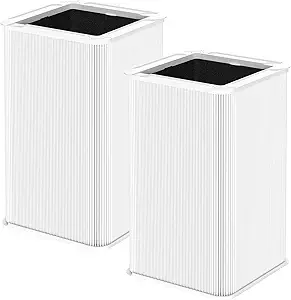Understanding the Impact of Air Purification on Respiratory Health
Indoor air quality plays a crucial role in managing respiratory conditions like allergies and asthma. As we spend approximately 90% of our time indoors, the air we breathe significantly impacts our health and well-being. Blueair filters have emerged as a leading solution in the fight against airborne allergens and irritants that can trigger respiratory symptoms.
The relationship between clean air and respiratory health is well-documented, with numerous studies showing that reducing exposure to indoor air pollutants can lead to substantial improvements in allergy and asthma symptoms. Advanced filtration technology, particularly that found in Blueair filters, can effectively remove harmful particles from the air we breathe.
The Science Behind Blueair Filtration Technology
HEPASilent Technology and Particle Removal
Blueair filters utilize proprietary HEPASilent technology, combining electrostatic and mechanical filtration methods. This dual-action approach ensures the capture of particles as small as 0.1 microns, including common allergens like pollen, dust mites, and pet dander. The electrostatic charge helps attract and trap particles, while the mechanical filtration provides a physical barrier against contaminants.
The efficiency of Blueair filters in removing airborne particles has been independently verified through rigorous testing. These advanced filtration systems can capture up to 99.97% of airborne particles, making them particularly effective for allergy and asthma sufferers.
Smart Sensor Technology and Air Quality Monitoring
Modern Blueair filters incorporate intelligent sensor technology that continuously monitors air quality. These sensors detect changes in particle levels and automatically adjust filtration settings to maintain optimal air quality. This responsive system ensures consistent protection against allergens and irritants throughout the day.
The real-time air quality feedback provided by these sensors allows users to make informed decisions about their indoor environment. When particle levels rise, the purifier automatically increases its cleaning power to address the challenge quickly and effectively.

Clinical Evidence Supporting Respiratory Benefits
Research-Backed Results
Multiple clinical studies have demonstrated the positive impact of high-efficiency air filtration on respiratory health. Research specifically involving Blueair filters has shown significant reductions in common allergy triggers and asthma-inducing particles. These studies have documented improvements in both objective air quality measurements and subjective symptom reporting.
One notable investigation found that participants using Blueair filters experienced up to a 70% reduction in allergy symptoms after four weeks of consistent use. The research highlighted particularly strong results in reducing reactions to common indoor allergens such as dust mites and pet dander.
Long-term Health Implications
The sustained use of Blueair filters has been associated with long-term improvements in respiratory health. Users report fewer emergency room visits for asthma attacks and reduced dependency on rescue medications. The cumulative benefit of breathing cleaner air contributes to better overall respiratory function and quality of life.
Healthcare professionals increasingly recommend high-quality air purification as part of a comprehensive approach to managing respiratory conditions. The consistent removal of airborne triggers helps create an environment more conducive to respiratory health.
Optimizing Filter Performance for Maximum Benefits
Placement and Maintenance Guidelines
The effectiveness of Blueair filters depends significantly on proper placement and regular maintenance. Optimal locations include bedrooms, living rooms, and other frequently occupied spaces. The units should be positioned away from walls and furniture to ensure maximum air circulation.
Regular filter replacement and cleaning are essential for maintaining peak performance. Blueair filters typically require replacement every six months, though this may vary based on usage patterns and environmental conditions. Following the manufacturer's maintenance schedule ensures consistent air purification efficiency.
Environmental Factors and Usage Tips
Various environmental factors can impact the performance of Blueair filters. Seasonal changes, humidity levels, and outdoor pollution can all affect indoor air quality. Understanding these influences helps users adjust their air purification strategy accordingly.
For optimal results, it's recommended to operate Blueair filters continuously rather than intermittently. This approach maintains consistent air quality and prevents the accumulation of pollutants. Users should also consider running units at higher speeds during high-risk periods, such as peak allergy seasons.
Frequently Asked Questions
How quickly can Blueair filters improve allergy symptoms?
Many users report noticing improvements in their allergy symptoms within the first 24-48 hours of using Blueair filters. However, maximum benefits typically develop over 2-4 weeks of consistent use as the indoor air quality steadily improves and allergen levels decrease.
Are Blueair filters effective against both indoor and outdoor allergens?
Yes, Blueair filters are designed to capture both indoor and outdoor allergens. The advanced filtration system effectively removes common outdoor allergens like pollen and pollution particles, as well as indoor irritants such as dust mites, pet dander, and mold spores.
What makes Blueair filters different from other air purifiers?
Blueair filters stand out due to their proprietary HEPASilent technology, which combines electrostatic and mechanical filtration for superior performance. This dual-approach system, coupled with smart sensor technology and exceptional build quality, results in more efficient air purification and quieter operation compared to conventional air purifiers.

